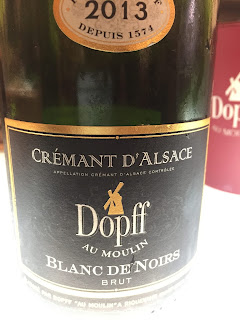Summer has now left Alberta and replaced it with a record setting 32.8cm snowfall on October 2! YUCK! Now that my palate is naturally craving the warmth of red wine, it's time to wrap up my Cremant Tour de France mini-series. The last stop? Burgundy.
Burgundy 's homeland grapes are the same as the varietals required for crafting Champagne: Pinot Noir and Chardonnay. In fact, the Cremant de Bourgogne appellation takes their vinification seriously: only hand-harvesting the grapes, utilising the same pressing process as in Champagne, and you must declare your production of Cremant in March, just before the growing season begins! The fruits of these labors are evident in the glass: elegantly structured, refined in style, and punches well above their weight when it comes to QPR!

I kicked off the warm weather season this year with Henri de Villamont Brut Blanc de Blancs. Composed solely of Chardonnay, this wine boasted abundant autolytic flavours of toasted hazelnuts and brioche, with an appealing hint of banana custard towards the long finish. Bright and lively mouthfeel, I enjoyed it immensely on its own!

The Bailly Lapierre Cremant de Bourgogne contains an intriguing blend of Pinot Noir, Chardonnay, Aligote and Gamay Noir, creating a palate of green apple, stony minerality, and freshly baked bread. Surprisingly delicate bubbles, but a bright acidity and citrus finish keep a well-structured balance. An excellent choice for weeknight bubbly!

The final bottle of my Cremant Tour de France was the same as my first glass ever of Cremant: Louis Bouillot Rose. Prominent notes of strawberries, raspberries and mandarin oranges, refreshing acidity, a bright mouthfeel and a true joy to sip! I prefer to enjoy this gem on its own-over, and over, and over again!
I truly enjoyed tasting my way through the Cremants of France, no matter what appellation they are from! They are an excellent alternative to Champagne when you don't want to spend a fortune, and pair extremely well with an array of food. The next time you feel like imbibing in bubbly, why not give a Cremant a try? You won't be disappointed.
I would love for you to share your Cremant tastings with me, either by commenting on this post or through the hashtag #cremanttourdefrance on twitter. I hope you enjoy your sips as much as I enjoyed mine.
Until next time, cheers all!
Burgundy 's homeland grapes are the same as the varietals required for crafting Champagne: Pinot Noir and Chardonnay. In fact, the Cremant de Bourgogne appellation takes their vinification seriously: only hand-harvesting the grapes, utilising the same pressing process as in Champagne, and you must declare your production of Cremant in March, just before the growing season begins! The fruits of these labors are evident in the glass: elegantly structured, refined in style, and punches well above their weight when it comes to QPR!
I kicked off the warm weather season this year with Henri de Villamont Brut Blanc de Blancs. Composed solely of Chardonnay, this wine boasted abundant autolytic flavours of toasted hazelnuts and brioche, with an appealing hint of banana custard towards the long finish. Bright and lively mouthfeel, I enjoyed it immensely on its own!
The Bailly Lapierre Cremant de Bourgogne contains an intriguing blend of Pinot Noir, Chardonnay, Aligote and Gamay Noir, creating a palate of green apple, stony minerality, and freshly baked bread. Surprisingly delicate bubbles, but a bright acidity and citrus finish keep a well-structured balance. An excellent choice for weeknight bubbly!
The final bottle of my Cremant Tour de France was the same as my first glass ever of Cremant: Louis Bouillot Rose. Prominent notes of strawberries, raspberries and mandarin oranges, refreshing acidity, a bright mouthfeel and a true joy to sip! I prefer to enjoy this gem on its own-over, and over, and over again!
I truly enjoyed tasting my way through the Cremants of France, no matter what appellation they are from! They are an excellent alternative to Champagne when you don't want to spend a fortune, and pair extremely well with an array of food. The next time you feel like imbibing in bubbly, why not give a Cremant a try? You won't be disappointed.
I would love for you to share your Cremant tastings with me, either by commenting on this post or through the hashtag #cremanttourdefrance on twitter. I hope you enjoy your sips as much as I enjoyed mine.
Until next time, cheers all!











